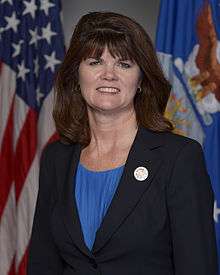Mica Endsley
Mica Endsley is an engineer and a former Chief Scientist of the United States Air Force. The position of the Chief Scientist was created over 60 years ago to provide independent scientific advice to the Secretary of the Air Force and the Chief of Staff of the Air Force, as well as to its senior leadership. In this role, she worked with the top scientists and engineers within the Air Force as well as in academia, industry, and the other armed services to ensure that the Air Force's research and development efforts remain relevant and effective. Additionally, as the Chief Scientist she responded to any tasking from the Secretary of the Air Force and the Air Force Chief of Staff on issues or opportunities of a scientific and technical nature that may arise. Endsley was the first human factors engineer[1] and the first female to serve as Chief Scientist.
Mica Endsley | |
|---|---|
 Former Chief Scientist of the U.S. Air Force | |
| Born | |
| Nationality | American |
| Education | Texas Tech University Purdue University |
| Alma mater | University of Southern California |
| Scientific career | |
| Fields | Engineering, Situation awareness |
| Institutions | United States Air Force, SA Technologies, Human Factors and Ergonomics Society, Journal of Cognitive Engineering and Decision Making |
Early life and education
Endsley was born in California and grew up in Phoenix, Arizona and Houston, Texas where she attended Spring Woods High School.[2] In 1982, Endsley graduated cum laude from Texas Tech University in Lubbock, Texas with Bachelor of Science degree in Industrial Engineering.[2] In 1985, she earned a Master of Science degree in Industrial Engineering from Purdue University and earned a Doctor of Philosophy in Industrial and Systems engineering from the University of Southern California in 1990.
Career
From 1997 to 2013, Endsley served as President and CEO of SA Technologies in Marietta, Georgia, a cognitive engineering firm specializing in the development of operator interfaces for advanced systems, including the next generation of systems for aviation, air traffic control, medical, power, oil & gas, and military operations. Prior to forming SA Technologies she was a Visiting Associate Professor at MIT in the Department of Aeronautics and Astronautics and Associate Professor of Industrial Engineering at Texas Tech University.
Endsley has authored over 200 scientific articles and reports on situation awareness,[3][4] decision making and automation and is recognized internationally for her pioneering work in the design, development and evaluation of systems to support human situation awareness and decision-making, based on her model of situation awareness. This human-centered design approach has been found to be critical to successfully integrating people with advanced technologies and automation in a wide variety of domains. In addition, Endsley has developed training programs for enhancing situation awareness among individuals and teams. She is co-author of two books, Analysis and Measurement of Situation Awareness and Designing for Situation Awareness.
She is Past-President of the Human Factors and Ergonomics Society where she is a fellow, was co-founder of the Cognitive Engineering and Decision Making Technical Group of HFES, and has previously served on its Executive Council. Endsley has received numerous awards for teaching and research, is a Certified Professional Ergonomist and a Registered Professional Engineer. She is the founder and former Editor-in-Chief of the Journal of Cognitive Engineering and Decision Making and serves on the editorial board for three major journals. Endsley received the Human Factors and Ergonomics Society Jack Kraft Innovator Award in 2003 for her work in situation awareness.
Selected publications
- Endsley, M. R. (1995). Toward a theory of situation awareness in dynamic systems. Human Factors, 37(1), 32-64.
- Endsley, M. R. (1995). Measurement of situation awareness in dynamic systems. Human Factors, 37(1), 65-84.
- Endsley, M. R., & Garland, D. J. (Eds.). (2000). Situation awareness analysis and measurement. Mahwah, NJ: Lawrence Erlbaum.
- Endsley, M. R., & Jones, W. M. (2001). A model of inter- and intrateam situation awareness: Implications for design, training and measurement. In M. McNeese, E. Salas & M. Endsley (Eds.), New trends in cooperative activities: Understanding system dynamics in complex environments (pp. 46–67). Santa Monica, CA: Human Factors and Ergonomics Society.
- Endsley, M. R. (2006). Expertise and Situation Awareness. In K. A. Ericsson, N. Charness, P. J. Feltovich & R. R. Hoffman (Eds.), The Cambridge Handbook of Expertise and Expert Performance (pp. 633–651). New York: Cambridge University Press.
- Endsley, M. R., & Jones, D. G. (2012). Designing for situation awareness: An approach to human-centered design (2nd ed.). London: Taylor & Francis.
References
![]()
- Paul Barach; Jeffery Jacobs; Steven E. Lipshultz; Peter Laussen (4 December 2014). Pediatric and Congenital Cardiac Care: Volume 2: Quality Improvement and Patient Safety. Springer. pp. 94–. ISBN 978-1-4471-6566-8.
- "Distinguished Engineer Citations". TTU.edu. Texas Tech University. Retrieved 5 December 2014.
- Alfred Hermida (14 October 2014). Tell Everyone: Why We Share and Why It Matters. Doubleday Canada. pp. 207–. ISBN 978-0-385-67957-2.
- Mica R. Endsley; Daniel J. Garland (1 July 2000). Situation Awareness Analysis and Measurement. CRC Press. pp. 12–. ISBN 978-1-4106-0530-6.